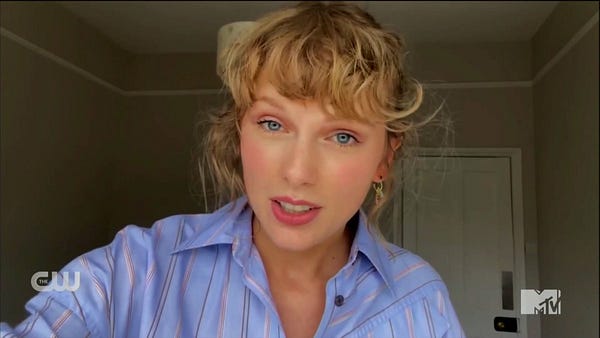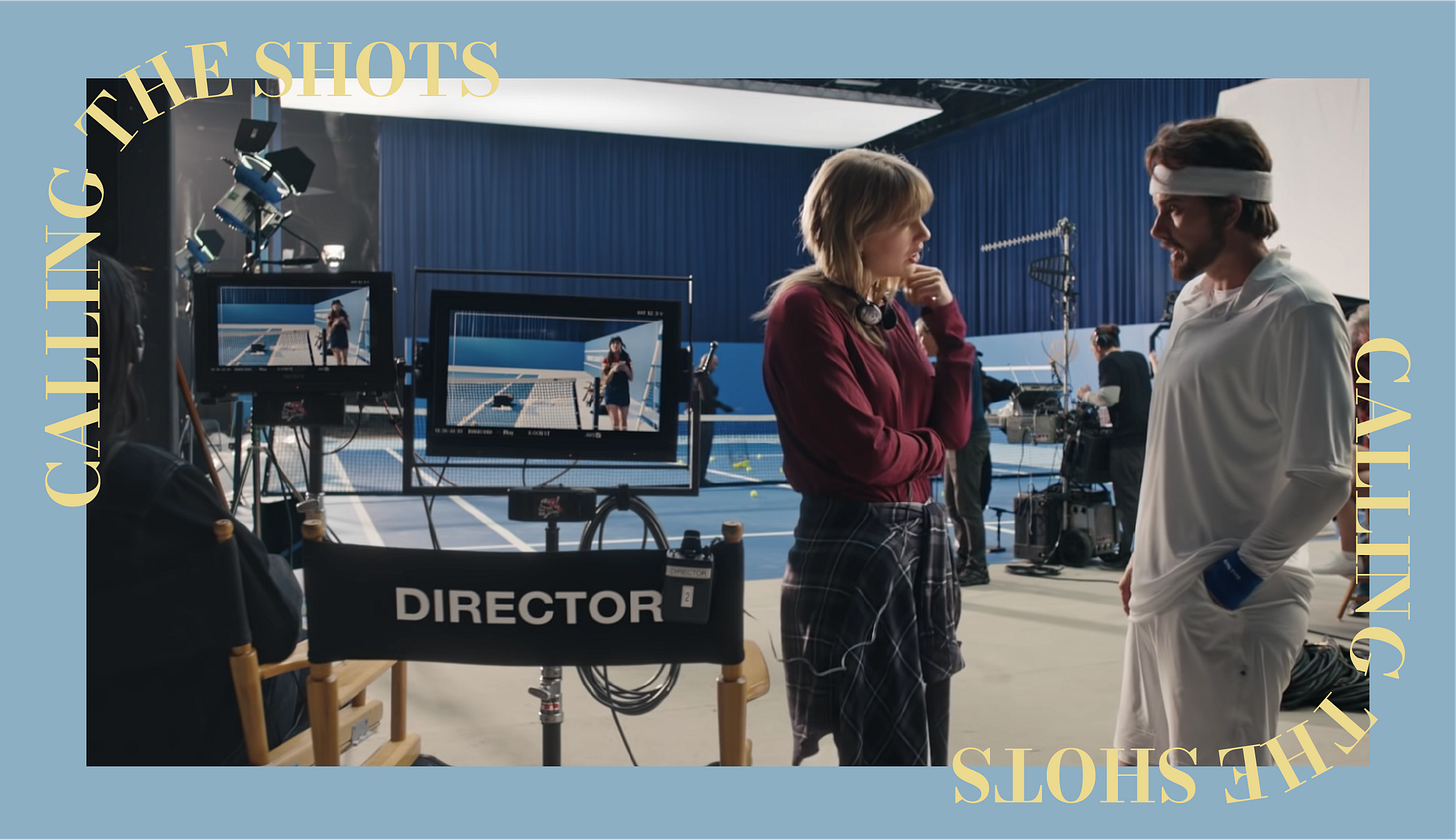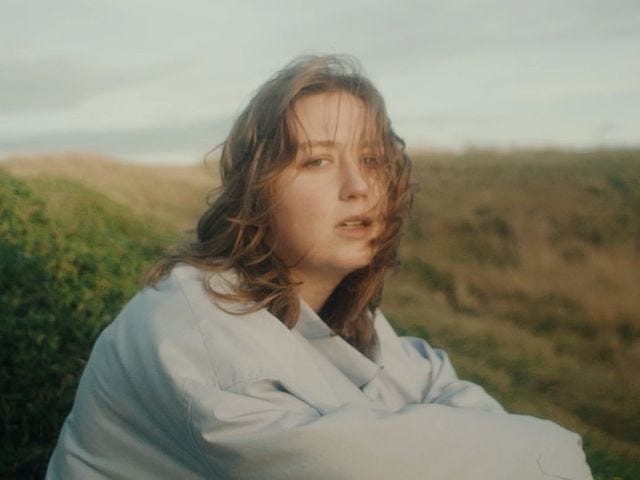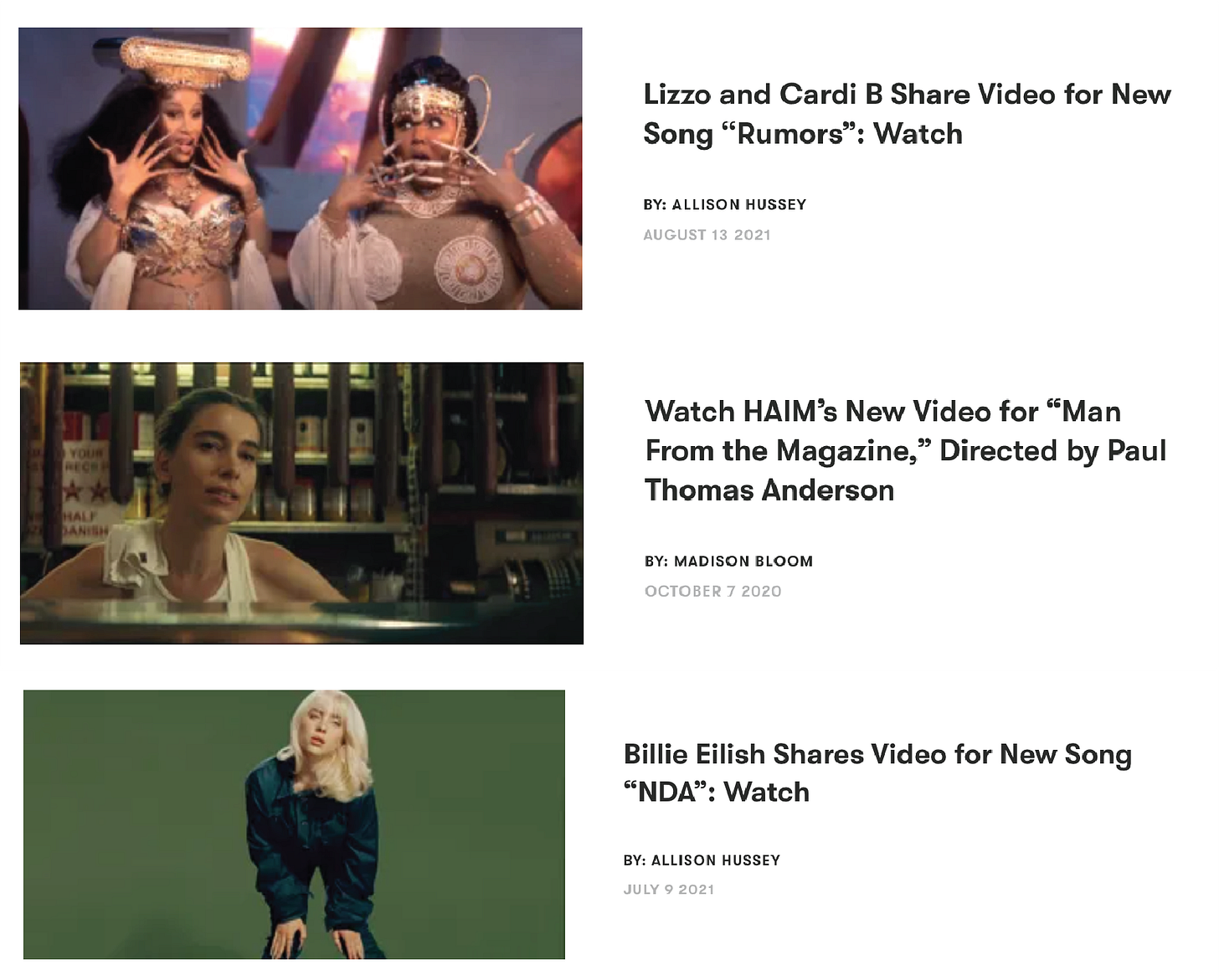Welcome back to The Vibes! If you missed August’s Ten Vibes, you can read them here.
Oh hi. Just me thinking about Big Pop again.
Is it confirmation bias? That thing when you notice something and then keep noticing it over and over and over and was it always this way? Nope! Turns out it is called frequency illusion—a cognitive bias! Great to know! Anyway. Over the past year or so, I keep noticing pop stars releasing music videos that they directed (or co-directed) themselves. This isn’t necessarily a new phenomenon—Beyoncé has co-directing credits on videos from 2007—but it does seem to be happening increasingly often.
Perhaps it’s an extension of celebrities taking control of their image, doing things on their terms. Forgoing the Vogue September issue profile, we get Beyoncé “In her own words” (as told to Clover Hope) instead of Hope interviewing and shaping a piece around Beyonce (or, more recently a clearly edited Q&A that appears more monologue than conversation). We see Harry Styles interviewing Timothee Chalamet, patting each other on the back for the brave act of wearing floral suits (to paraphrase). Taylor Swift writes a listicle (!) and a poem. But (and it’s been said many times by many people much smarter than me) a celebrity seemingly talking to you and cutting out the middleman is almost always less interesting and less *sigh* authentic than seeing the celebrity through the middleman’s eyes. When that profile hits, it hits!
In a similar vein (stay with me), we live in a time where artists want to be acknowledged as songwriters rather than just singers. A Big Pop artist like Ariana Grande, even over the span of her past 3 releases, has gone from having writing credits on 2/3rds of the tracks on 2018’s Sweetener to being credited on every song on both 2019’s Thank U Next (on “7 Rings” she sings “Write my own checks like I write what I sing”) and 2020’s Positions. Olivia Rodrigo “consider[s herself] a songwriter first”.

Where a couple of years ago people were bemoaning the fact that pop artists don’t write their own songs anymore, we’re now in an age where the aesthetics of (white) Pop Music and Bedroom/Guitar Music are becoming increasingly intertwined, held together by Jack Antonoff for the Millennials and Dan Nigro and Finneas in Gen Z (blah blah producers aren’t responsible for artists’ sound blah blah blah). Both Bedroom and Guitar Music are much more associated with confessional songwriting—O.R. went as far to say that when she writes in her bedroom she feels like it’s more intimate than writing anywhere else—and gives the impression that there really isn’t anything in between the singer and the listener, to quote the musician and philosopher Agnés Gayraud, we “omit the mediation and believe that we are contemplating the source.”
Now, back to the self-directed music videos. The pop stars are taking control of their image by taking control of the camera. I want to look a little bit at Taylor Swift whose directorial credits aren’t so much about creative vision (primarily, in my mind, because the aesthetics of her videos are No Good) but more about having something to prove.
Whilst having previously co-directed the “Mine” video in 2009, a string of co-directing credits came in 2019 for music videos for the singles off the Lover album, importantly the first album of songs to be ‘owned’ by Swift. She made her solo directing debut with her Girlboss of Wall Street video for “The Man” off Lover and then the videos for “Cardigan” and “Willow” from her pandemic releases, Folklore and Evermore.
The video for “The Man” seems especially made to fit a certain narrative, the one that Swift and her fans have been pushing since her masters were sold, first to Scooter Braun and then to the private equity group Shamrock Holdings. The responses from her fans regarding new releases shout how proud they are (of a multimillionaire they’ve never met) as they remind each other that she OWNS her music now and not to listen to the old recordings! And now she even directs her own music videos! Take that Scooter! A VMA win all but confirmed that the video’s—and even the song’s—existence was, for the fans, about the narrative of the Swift’s career not about the quality of the art. Fitting, I guess, for the song though.


On the other side of that idea, I talked a little bit with FoTV Stella Farnan who recently put out a self-directed music video for her song, “The Blue” off her upcoming EP Come Stay At Mine (out on the 27th! Presave, stream, etc.) While the decision to direct the video herself was partly based on budget and logistics, she developed the “concept for the video— I had references, I had drawn up my own treatment … and so [all] I really needed was someone to shoot it.” It wasn’t so much about being The Director for Stella, if her cinematographer ended up contributing more to the video than initially planned for, he might have the title— “the goal was [to execute] this idea that I’d already come up with so however it is that we create it is the way that we create it”— the video was made to service the art not her ego.
Okay, so there’s the ‘I Am A Director’ narrative but there’s also the auteur one, the creative visionary, the ‘nobody else could communicate this concept apart from me’. Let’s use Billie Eilish as an example, seeing as 10 out of her 22 music videos have been self-directed. When asked why by J*mmy F*ll*n in a recent appearance on The Tonight Show, she said “Sometimes when you have your own idea, and you know what you want … the best way to go about it is to do it yourself— even though it takes much more out of you.” So in this case, there’s a complete lack of desire to allow anyone else to co-opt the vision she sees for her music.
In the end, both narratives reach a similar conclusion because this isn’t about the quality of content or a unique premise, pop stars are directing their own videos because they want control. I’m not about to say that a young artist like Billie Eilish shouldn’t have control over how she is presented and perceived but in an increasing effort to appear as, and release works that are perceived as, ~authentic~ we only gain a more and more filtered view of the artist through the eyes of the artist.
Obviously part of that is the songwriter thing— artists who release under their own name have (maybe) a closer relationship with their work out in the world because it is directly tied back to them. Stella noted that because her songs come out under the ‘Stella Farnan’ name she feels that “when your musical project is viewed as ‘you’ no matter how curated it is … [it’s] really important [to think] about what I want the project to look like and feel like in all these other non-musical elements.” Personally, I don’t think it’s a coincidence then that “The Blue” happens to be the video that Stella feels reflects her work (and herself) most accurately—perhaps so much so that the cover art for the EP is a shot from the video.
It certainly appears empowering that an artist can release a music video and say ‘I directed it’ but unless they’re being nominated for an award, they’re still getting the credit. If we’re honest, Deja Vu is an Olivia Rodrigo video not an Allie Avital video for Olivia Rodrigo. The only situation where this isn’t the case is in a Haim/Paul Thomas Anderson or Phoebe (Waller-) Bridge(rs) scenario where the director is ‘important’—
But in writing all of this, does it really matter? The music video directors for hire are still getting jobs from the artists who want the big spectacle—just this year, the director of the Lizzo/Cardi B video (Tanu Muino) has directed Cardi B’s video for Up, Normani’s video for Wild Side, and (with the artist) Lil Nas X’s Montero—and pop stars who want to have full control over their image and aesthetics, who want to create ‘cinematic universes’ and sprinkle in easter eggs for their stans, will do it their way.
Next Ten Vibes will be out in 2 weeks!
Until then :)
Bianca





